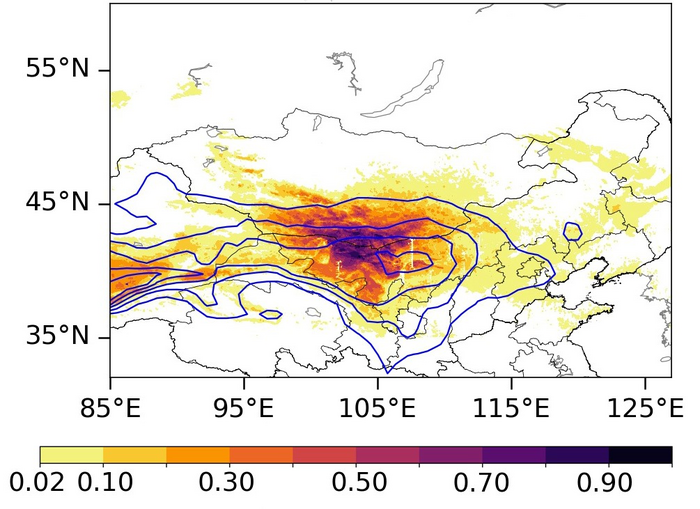During 13–16 March 2021, an extremely strong dust storm struck Mongolia and northern China successively, causing 590 herdsmen to disappear and 16 people to die in Mongolia. When the dust storm reached central Inner Mongolia in the early morning of 15 March, the gust speed reached up to 40 m s−1, which is equivalent to the intensity of a grade 12 typhoon. When it arrived in the Beijing–Tianjin–Hebei region on the morning of 15 March, visibility decreased sharply and the concentration of coarse particulate matter in the air over Beijing reached as high as 9000 μg m−3 locally. Research shows that extreme dust-storm weather such as this is caused by the rapid intensification and eastward movement of a Mongolian cyclone.

Credit: Cholaw Bueh
During 13–16 March 2021, an extremely strong dust storm struck Mongolia and northern China successively, causing 590 herdsmen to disappear and 16 people to die in Mongolia. When the dust storm reached central Inner Mongolia in the early morning of 15 March, the gust speed reached up to 40 m s−1, which is equivalent to the intensity of a grade 12 typhoon. When it arrived in the Beijing–Tianjin–Hebei region on the morning of 15 March, visibility decreased sharply and the concentration of coarse particulate matter in the air over Beijing reached as high as 9000 μg m−3 locally. Research shows that extreme dust-storm weather such as this is caused by the rapid intensification and eastward movement of a Mongolian cyclone.
Mongolian cyclones are often generated over the Mongolian Plateau in spring, but it is extremely rare for a Mongolian cyclone to develop into a super-strong cyclone with typhoon intensity. The topography of the Mongolian Plateau alone is not the key reason for a Mongolian cyclone developing into a super cyclone, because the terrain remains unchanged, but the intensity of Mongolian cyclones varies from case to case. Diabatic heating is the primary mechanism for explosive cyclones over sea areas, but this is obviously not the reason for an extreme intensification of the Mongolian cyclone.
Recently, a research team from the Institute of Atmospheric Physics, Chinese Academy of Sciences, revealed the development process and contributing factors of this powerful Mongolian cyclone case in 2021, from the perspective of high-frequency eddy energetics. The results have been published in Atmospheric and Oceanic Science Letters.
“If the upstream upper-tropospheric disturbance that triggered the Mongolian cyclone had already been sufficiently strong when it approached the Mongolian Plateau, the combined effect of the Mongolian Plateau’s topography and the downward transfer of eddy kinetic energy would have been favorable for the occurrence of a strong Mongolian cyclone in the lower troposphere”, explains Prof. Cholaw Bueh, the first and corresponding author of the paper. “And if the anomalous state of the circulation at the interannual scale can also provide a more favorable background at this time in terms of available potential energy, the high-frequency disturbance will obtain more eddy available potential energy from the time-mean available potential energy such that the Mongolian cyclone will develop into an even stronger cyclone”.
The team confirmed this viewpoint from the perspective of the eddy energy budget. The downward transfer of eddy kinetic energy at 850 hPa played a key role in the strengthening and maturation stage of the Mongolian cyclone. This mechanism was mainly contributed by the sinking process of cold air behind the cold front. Once the cyclone began to develop rapidly, the mechanism of the frontal cyclone wave became very important. At this time, the interannual temperature anomaly pattern of “cold in the north and warm in the south” provided a highly favorable condition for the high-frequency disturbance to obtain the eddy available potential energy from the time-mean available potential energy.
“Becoming a super-strong Mongolian cyclone needs a favorable low-frequency background circulation condition as well,” adds Dr. Zuowei Xie, a coauthor of the paper. To verify the above assumption, the team derived a simplified version of the high-frequency eddy energy budget equation. The interaction term between high- and low-frequency eddies in the equation reflects the role of the low-frequency background circulation.
“During an intense development of the Mongolian cyclone, the high-frequency eddy also draws energy from the low-frequency available potential energy and strengthens further. The interaction between high- and low-frequency waves is also very important for the intensification of the Mongolian cyclone”, explains Dr. Anran Zhuge, another coauthor of the paper. Their work shows that the low-frequency temperature anomaly pattern of “cold in the northwest and warm in the southeast” is indeed highly conducive to the conversion of high-frequency eddy available potential energy from low-frequency eddy available potential energy.
As has been noted, the development of the Mongolian cyclone into a super-strong cyclone requires various favorable conditions, including the intensity of the weather disturbance itself over the Mongolian Plateau, the interaction between the disturbance and the topography, the low-frequency background circulation, and the interannual anomalous circulation background.
“The subtle role of the Mongolian Plateau’s topography has not yet been clearly revealed. The contributions of the topography to the downward transfer process of eddy kinetic energy and to the amplification of eddy available potential energy conversion from its background counterpart still need to be further revealed”, concludes Prof. Cholaw Bueh.
Journal
Atmospheric and Oceanic Science Letters
DOI
10.1016/j.aosl.2022.100259
Article Title
The development of a powerful Mongolian cyclone on 14–15 March 2021: Eddy energy analysis
Article Publication Date
17-Jun-2022




